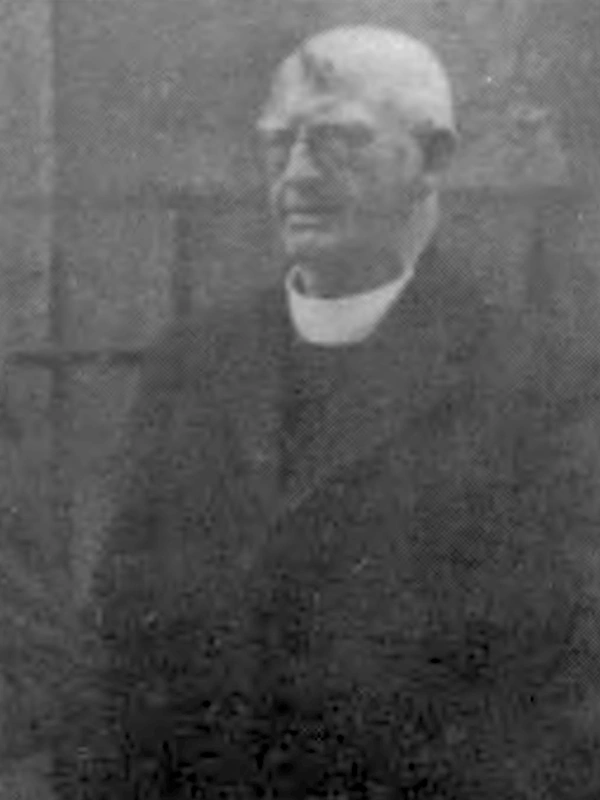Rev. Joseph McGivney
Biography

Early Life and Scholarly Pursuits
Rev. Joseph McGivney was born in 1864 in the townland of Cornee, near Mohill in County Leitrim, Ireland. He entered the priesthood in the Diocese of Ardagh and Clonmacnoise and developed a keen interest in local history and the Irish language early in his career. This scholarly bent culminated in the publication of Place-names of the County Longford : collected from various sources / correctly spelled in Irish and fully explained in English with notes and illustrations by Joseph MacGivney in 1908, a work that remains a valuable resource for researchers and local historians.
Before his appointment as parish priest in Aughavas in 1920, Rev. McGivney served in a number of curacies within the Diocese of Ardagh and Clonmacnoise. Around 1899, he was a curate in Ballymachugh, County Cavan, where he became known for his thoughtful preaching and pastoral dedication. By 1908, during the period in which he completed and published his book on Longford place-names, he was serving as a curate in Abbeylara, County Longford. His immersion in these communities undoubtedly deepened his engagement with the linguistic and historical landscape of the region, shaping the insights that informed his scholarly work.
The research into the place-names of Longford was grounded in a methodical approach that combined documentary evidence with oral tradition. Rev. McGivney drew on a wide array of sources, including early maps, ecclesiastical records, and local lore gathered from native Irish speakers, many of whom retained knowledge of the older Irish names and their meanings. His fluency in Irish enabled him to interpret these names with linguistic precision, often tracing their roots to early Gaelic and pre-Gaelic origins. The work reflects not only a linguistic analysis but also deep cultural and historical insight into the evolution of the landscape and settlement patterns of County Longford.
Rev. McGivney’s book was received with appreciation by scholars of Irish toponymy and by the wider public, especially at a time when cultural nationalism was fostering renewed interest in Ireland’s native heritage. His contribution helped preserve many names that might otherwise have been lost or misinterpreted as the English language became dominant in official and cartographic contexts. His work continues to be cited in historical and linguistic studies and serves as a model of early 20th-century local scholarship. Academic circles, particularly those focused on Irish toponymy and historical geography, have noted the significance of Rev. McGivney’s careful methodology and the breadth of local knowledge he preserved. Scholars have referenced his work in comparative studies of place-names across Irish counties, and it has been recognized for contributing to the preservation of Ireland’s intangible cultural heritage. In particular, his use of oral traditions to supplement written sources has been praised as an early example of integrating community memory into formal scholarship, prefiguring later interdisciplinary approaches in folklore and ethnology.
Parish Priest of Aughavas (1920–1930)
In 1920, Rev. McGivney was appointed parish priest (P.P.) of Aughavas in south County Leitrim, a rural parish that he would profoundly shape. He found the parish’s old 19th-century chapel (built in 1837) in an advanced state of dilapidation. Determined to provide his flock with a sound and spacious place of worship, he immediately set about plans for a new church. In 1922, he formed a building committee and launched an ambitious fund-raising campaign. Rev. McGivney appealed not only to his parishioners at home but also to those who had emigrated abroad, rallying support from Aughavas natives in the United States and beyond. His passionate appeals inspired generous donations, and he himself contributed £450 out of his own pocket toward the project (a substantial sum for the time). Such was his commitment that he frequently donned work clothes and joined the laborers on site – local lore recalls that Rev. McGivney worked alongside his workmen almost daily, even helping to quarry and select the best stones for construction. This hands-on leadership, combined with his gentle humor and tireless energy, motivated parish volunteers to offer their labor enthusiastically.
Construction of the new church – to be dedicated to St. Joseph – began with the laying of the foundation stone on 1 July 1925. A new, more accessible site was chosen for the building, and sturdy limestone was quarried locally for the walls. Much of the heavy work, from hauling stone and sand to mixing mortar, was carried out by parishioners organized in volunteer brigades. Each local farming family contributed time, teams of horses, and carts to ferry materials, creating a spirited community effort. Rev. McGivney oversaw the project closely in cooperation with the contracted builder, Thomas Fleming of Newry, County Down. Under this joint professional and volunteer endeavor, the walls rose quickly. By June 1927 the structure was largely complete, capped with a roof of sturdy timber. The new Gothic-style church was an impressive edifice for its rural setting, and it ultimately cost in the realm of £10,000 to build – a huge undertaking for the small parish. Notably, the ornate high altar of the church was a historic piece itself: carved from Caen stone and sourced from a decommissioned church in Portadown, it was acquired and installed as the centerpiece of the sanctuary, where it remains intact to this day.
The church’s completion marked a high point of Rev. McGivney’s Aughavas tenure. Once sufficient funds had been raised to cover the building debt, the new St. Joseph’s Church was solemnly dedicated on 23 June 1929 by Bishop Joseph Hoare of Ardagh. (The two-year gap between completion and dedication allowed the parish to pay down its obligations, reflecting Rev. McGivney’s prudent management.) The achievement was heralded as a testament to the unity and faith of the people of Aughavas under Rev. McGivney’s guidance. In a poignant historical footnote, many years later a glass bottle was discovered beneath the church’s sacristy floor, containing a contemporaneous note memorializing the project: it recorded the church’s foundation date (1 July 1925) and completion date (June 1927), and honorifically situated the new building in “the reign of Pope Pius XI, Joseph Hoare Bishop of Ardagh and Joseph McGivney Parish Priest.” This time-capsule message from the past vividly underscored the lasting legacy of Rev. McGivney’s work in Aughavas.
Service in Killoe and Later Years (1930–1950)
Having secured the future of Aughavas’s church, Rev. McGivney was transferred in June 1930 to serve as parish priest of Killoe in County Longford. He thus returned to the county that had inspired his earlier scholarship. For the next two decades, Rev. McGivney ministered in Killoe, providing steady pastoral leadership throughout the 1930s and 1940s. By all accounts he was a devoted pastor, known for his erudition and gentle demeanor. Now a senior cleric in the diocese, he continued to be respected for his intellect as well as his practical wisdom gained from years of rural ministry.
On 3 June 1950, at the age of 85, Rev. McGivney resigned as parish priest of Killoe, retiring from active ministry after 30 years of heading parishes. His resignation marked the end of a remarkably productive clerical career that spanned from the late 19th century into the mid-20th century. The Diocese recognized his long service; he lived out his retirement years quietly.
Death and Legacy
Rev. Joseph McGivney died in 1958 in Edgeworthstown, County Longford, closing the final chapter of a life devoted to faith, learning, and community. He was in his ninety-fifth year. Fittingly, his burial took place back in the region he served – he was laid to rest in Killaraght cemetery near Boyle, Co. Roscommon, among the people and landscape that had shaped his ministry.
Rev. McGivney’s legacy endures both in the physical and cultural heritage of the area. The sturdy stone church he built in Aughavas stands to this day as the spiritual and social heart of the parish, a living monument to his vision and the collective effort he inspired. Its Caen-stone high altar from Portadown – still intact and in use – silently tells of his resourcefulness in marrying history with progress. Equally enduring is his contribution to local scholarship: Place-names of the County Longford remains a reference work cited by historians and enthusiasts exploring the meanings of Ireland’s townland names. Through that book, Rev. McGivney preserved a wealth of folklore and linguistic insight for future generations.
In the annals of the Diocese of Ardagh, Rev. Joseph McGivney is remembered as a priest who combined learning with leadership. He demonstrated how a deep love of heritage could go hand in hand with practical action for one’s community. Whether compiling the ancient names of Longford or sweating alongside parishioners to raise a new church from the Irish earth, Rev. McGivney brought a singular devotion to his work. His life’s story – from humble beginnings in rural Leitrim to celebrated scholar-priest and builder of churches – continues to inspire those who value the rich tapestry of local history and the strength of community faith.
Works
- Place-names of the County Longford (1908)
- The Morans and the Mulveys of South Leitrim [Ardagh and Clonmacnoise Antiquarian Society Journal, 1(3), 14–19] (1932)
References
- Brief history of Aughavas
- Death of Mr. James Conefrey, Late of Mohill. (1908, September 24). Leitrim Advertiser, p. 3.
- Death of Rev. James Brady, Late C.C., Ballymahon. (1899, March 18). Roscommon Herald, p. 9.
- Dictionary of Irish Architects
- McGivney, J. (1908). Place-names of the County Longford. James Duffy and Co.
- McGovern, A. (2021, September 23). This is St Joseph’s Church Aughavas [Image attached] [Post in Leitrim Old Irish Photos group]. Facebook. https://www.facebook.com/groups/430178494975850/posts/562963375030694/
- McNamee, J. J. (1954). History of the Diocese of Ardagh. Browne and Nolan.
- Whelan, M. (1998). The parish of Aughavas, Co. Leitrim: Its history and its people. M. Whelan.
